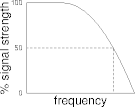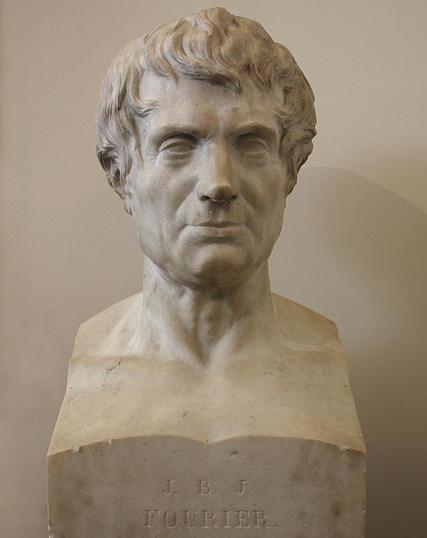Computer Networking Lecture Notes
2013 November 14 • Data Communication
Outline
- Review and placement.
- Signals
- Representing signals.
- Fourier series.
- Signals under transmission.
- Maximum data rates.
- Nyquist’s and Shannon’s theorems.
Another View
- Networks look like this:

- However, networks also look like this:

- Digital: a fake, two-valued world.
- Analog: the real, infinitely-valued world.
The Physical Layer
- The physical layer mediates between a system and its
environment.
- A system: the host; an environment: the network.
- The physical layer does almost no networking.
- It translates between digital and analog representations.
- The translation’s defined by physics, engineering, and the network.
Signals
- A signal is a time-varying characteristic of a physical medium.
- Voltage or current in a copper wire.
- Displacement from rest in a piano string.
- A signal can be represented as a function of time g(t).

Periodic Signals
- A periodic signal repeats itself regularly.

- The cycle is the smallest repetition unit.
- The period (wavelength) is the cycle length.
- A finite duration signal can be made periodic by repetition.
Example
- The ASCII representation for ‘
b’ is 01100010.
- Repeat g(t) to get the periodic signal
g′(t).

Frequency
- The frequency f of a periodic signal is the period p
inverted.
- p time per cycle.
- f = 1/p Hz, Hertz or cycles per time.
- A parameter on variable t is a proportional knob for frequency.

Representing Signals
|
|
Jean Baptiste Joseph Fourier 1768–1830 |
Fourier Series
- If g(t) is a periodic function with period T, then

where
f = 1/T is the fundamental frequency.
is the Fourier series for g(t).
an, bn are the nth harmonics.
c is a constant.
Fourier Parameters
- Integrate g over the period T to find c:

- Integrate to find the ith harmonics:

Parameters Example
- Given the periodic version of the ASCII ‘
b’ function
- the Fourier parameters are

Approximation Example
Move the mouse over the upper coordinate of a harmonic plot to select that harmonic and all earlier ones.
Harmonics
- Each harmonic represents a component signal.
- Higher harmonics represent higher-frequency signals.
- The first trade-off: harmonic count vs approximation accuracy.
- The more harmonics included, the more accurate the approximation.
- But what’s the cost of including a harmonic?
Attenuation
- Attenuation is the lost of signal power due to “friction.”
- Most media attenuates higher frequencies more than lower frequencies.
- Unequal harmonic attenuation leads to signal distortion.
- One answer:
- Don’t use harmonics that will be distorted.
Bandwidth
- Bandwidth is the frequency range assigned to a signal.
- An FM channel has a 200 kHz bandwidth.
- A medium’s bandwidth is the frequency range over which attenuation is
not too bad.

- “Not too bad”: ≤ 50% attenuation.
- There other definitions.
Maximum Data Rates
- A signal s has bandwidth B Hz.
- Nyquist’s sampling theorem:
s can be exactly reconstructed from 2B samples per second.
- If s uses V discrete levels, then
- maximum rate = 2B log2 V bits/sec.
- For example: a 3kHz channel sending binary
- 2·3,000 log2 2 = 6,000 bits/sec.
Signals and Noise
- Nyquist assumes a perfect errorless channel.
- Real channels have errors.
- Modeled as random (thermal) noise (white noise).
- A channel has signal S and noise N.
- The signal-to-noise ratio (SNR, S/N) is
Maximum Data Rates
- A noisy channel has bandwidth B and SNR E.
- The maximum data rate (capacity) is
- B log2 (1 + E) bit/sec.
- This is Shannon’s theorem.
- For example, a noisy channel has 1 MHz bandwidth and 40 dB SNR.
- Capacity = 1 MHz log2 (1 + 40) = 5.3 Mb/sec.
Summary
- A signal is a collection of harmonic signals (frequencies).
- Signal attenuation places constraints on signals.
- In particular, finite bandwidth.
- Bandwidth and signals (levels or noise) lead to maximum data rates.
- Either by Nyquist (levels) or Shannon (noise).
References
- Certain Factors Affecting Telegraph Speed by Henry Nyquist in the Bell System Technical Journal, July, 1924.
- A Mathematical Theory of Communication by Claude Shannon in the Bell System Technical Journal, July, 1948.
Credits
- Grenoble - ancien évêché - Joseph Fourier by Eusebius@Commons under a Creative Commons AT license.
| This page last modified on 2013 February 14. |

